Feel free to copy this file or use it as you will This file was shared with KeelyNet courtesy of Bruce Hegerberg from a booklet Minto was giving away many years ago to get people excited and building his machines. Bruce transcribed and scanned it to a floppy which I misplaced. I finally found it so that it could be posted, enjoy and thank Bruce if you see him. It could just as well have been printed up and sold but was intended to be shared freely and so it shall be thanks to Bruce. If you build this, please send photos and descriptions of what kind of results you are getting in operation to either Jerry or Chuck @ KeelyNet or to any other website who also freely shares information and we can reference their URL. Its not WHO does it, just that it GETS DONE. Thanks! You might want to check out this file to get an idea of what it does and how it does it;Wally Minto's Wonderwheel - 04/30/97 Our forefathers used waterwheel to produce power, power which changed man's way of life and increased productivity. Today, when we know that our supply of energy from fossil fuels (including uranium) is exhaustible, every consideration should be given to tapping renewable energy sources.
Wallace Minto, a scientist internationally-known for his development of a pollution-free automobile engine, has developed a practical version of an engine that runs on small temperature gradients to produce useful power. Such small temperature gradients are plentiful almost everywhere on earth, or can easily be produced from solar energy.
The engine consists simply of a wheel with a series of sealed containers fastened around its rim. Diametrically opposite pairs of containers are connected by tubes. A low-boiling liquid, like propane, butane, carbon dioxide or Freon is sealed into the bottom container and subjected to a very mild increase of temperature. This causes a part of the liquid to vaporize, producing a higher pressure on the surface of the remaining liquid. This pressure forces the liquid up the connecting pipe until it spills into the opposite container at the top of the wheel.
This shift of mass causes the top container to become heavier while its opposite number at the bottom of the wheel becomes lighter, and the force of gravity causes the wheel to turn, in the same manner that water turns a water wheel. As the filled container nears the bottom of the wheel, it is in turn subjected to the influence of the heat source, and it then discharges its liquid into the original container which is now empty at the top of the wheel, having cooled as it traveled upward. This cycle is repeated indefinitely with no loss of the contents of the sealed chambers and the wheel keeps turning as long as there is an adequate temperature difference between its bottom and top.
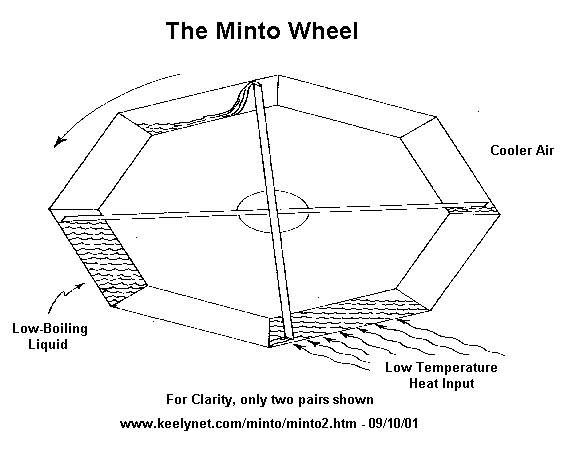
No significant power can be produced from ordinary fluids that have relatively high boiling points, such as water or alcohol. Their vapor pressures are too low at temperatures near ambient. In addition, it takes too much heat energy to vaporize a pound of their liquid. However, today we have available liquids that vaporize to produce high differential pressures at very modest temperature differences. The use of these fluids is what makes the Minto wheel practical as a power source. Units of modest size could perform such tasks as pumping water for irrigation, grinding food grains and generating small amounts of machine power on a farm-by-farm basis. A temperature gradient of as little as two degrees Celsius (about 3½ degrees F.) will drive a wheel ten meters (33 feet) in diameter. Such small temperature differences are abundant almost everywhere in nature: such as the temperature difference between water and cooler air, or even the difference between direct sunshine and shade.
The wheel turns relatively slowly, but produces enormous torque, or twisting effect on a shaft; this can be geared up through gears or belting to produce any speed desired at the final output shaft.
The Minto wheel is simple and inexpensive to build and is virtually maintenance free. When constructed of suitable materials and supplied with heat, a single unit can keep grinding out power for generations.
The wheel is simple to construct because no precision machine work is required. It is designed to be built from those materials most readily at hand in your community. The drawings herewith are intended to serve as a guide, or an example of such construction, but the exact dimensions given need not be followed closely. We suggest full exercise of your ingenuity in substituting parts available on most farms, from automobile junkyards, or your local refrigeration and air-conditioning serviceman.
Certain basic considerations in the design of a wheel are:
1. The main body of the working liquid should be heated as little as possible. Side arm tubes, for example, could be used to heat and vaporize only that portion required to pressurize the chamber.
2. The power output capability of the wheel depends upon the temperature differential available to drive it.
3. Extended surfaces should be employed to facilitate heat transfer.
4. Heat transfer to structural parts, particularly main container walls, should be minimized. Minimize the weight of the structural parts heated.
5. Higher density liquids maximize horsepower output from a given wheel operating at a given RPM.
6. Dual liquid fillings can be employed for special purposes. For example, using mercury as the shifting mass, powered by propane as the volatile fluid, tremendous torque can be generated with a relatively small diameter wheel.
7. The choice of working fluid is governed by optimum compromise among these factors, at the temperature range to be used.
Minimize:
Cost
Latent heat of vaporation of liquid
Specific heat of fluid
Viscosity of liquid
Maximize:
Vapor pressure
Ratio of the specific volume of the vapor to that of the liquid
Liquid density
TANKS:The tanks around the rim are the most difficult part, so they should be made first. They are conveniently fabricated from pipe, (such as aluminum irrigation pipe) by welding, brazing or soldering. If you do not have the facilities to make hermetically-sealed tanks, you can get assistance from that modern-day equivalent of the village blacksmith - your local welding shop. Or you may be able to improvise from surplus oxygen flasks or vacuum reservoirs from an auto junk yard. Throwaway freon tanks in 25 pound sizes make excellent tanks that are often available very cheaply from your local refrigeration and air conditioning service-man. Aluminum is desirable because of its lightness and durability, but steel is easier to weld, braze or solder.
On the other hand, welded joints are not essential. Carefully threaded and doped joints are satisfactory. If slip-on end caps are used, they may be applied with a good epoxy adhesive to form a hermetic seal.
After each tank is fabricated with a short side tube, we recommend it be tested with compressed air, applying soapy water liberally to all joints to check for leaks. You can fit a tire valve stem to the side tube and use a tire pump or take it to your local service station.
If you are concerned about the strength of your tanks, we recommend that you fill them with water before pressurizing. You can even pressurize them solely with water from your domestic supply. Since the compressibility of water is small at these modest pressures, this removes any danger from rupture on testing.
The number of tanks around the rim is not crucial, except that it must be an even number. We recommend at least eight tanks, or four pairs to get a reasonably-smooth power flow. The larger the tank diameter, the greater the developed torque. But larger tanks have a smaller relative area for heat transfer.
If you are using larger tanks, such as old freon containers, it is preferable to silver solder or braze on several copper U-bends to the outer side of the tanks. The volatile liquid can then flow into the copper tubes and vaporize in them to produce the pressure needed to force the bulk of the liquid up the radial tubes and into the opposite tank, Similarly, these tubes will enhance condensation of vapor in the top tank.
If you are fabricating tanks from pipe, we recommend that you insert in each tank a rolled-up piece of corrugated aluminum sheet to make a multiplicity of small channels next to the tank wall, This will improve heat transfer and tend to vaporize the fluid next to the wall with less heating of the main liquid mass.
Alternate ways to join the side arm tube to the tank:
1. Purchase brass adapters which are threaded with standard ½ inch Iron Pipe Thread on one end and ½ inch tubing compression fitting on the other end. Bore these out so that the ½ inch tubing slides all the way through. A thick walled tank may then be drilled and tapped to accept the ½ inch I.P. end, which is installed using Permatex or other good pipe dope. The side arm tube is slid into final position with its brass grommet and nut in place and tightened down. A little smear of Permatex on the tube before tightening will insure a leak-proof tube joint.
2. A brass plug threaded for ½ inch or 3/4 male IPT may be drilled through to accept a short length of ½ inch copper tubing, which is then soft-soldered into proper position. The brass plug is installed in the tank wall as in #1 and the radial tube connected to the opposite tank by solder sweat fittings.
3. If the tank has a thin wall, a short length of tubing may be soldered or brazed in position. If the tank is steel, use copper tubing and braze, silver solder or hard solder in place. If the tank is aluminum, use an aluminum tube and special aluminum solder to make the joint. You can also solder a copper tube through an aluminum tank using a special solder. These special self-fluxing aluminum solders are available from dealers listed in the appendix. Follow directions carefully and try soldering some scrap pieces until you get the knack of using these special alloys.
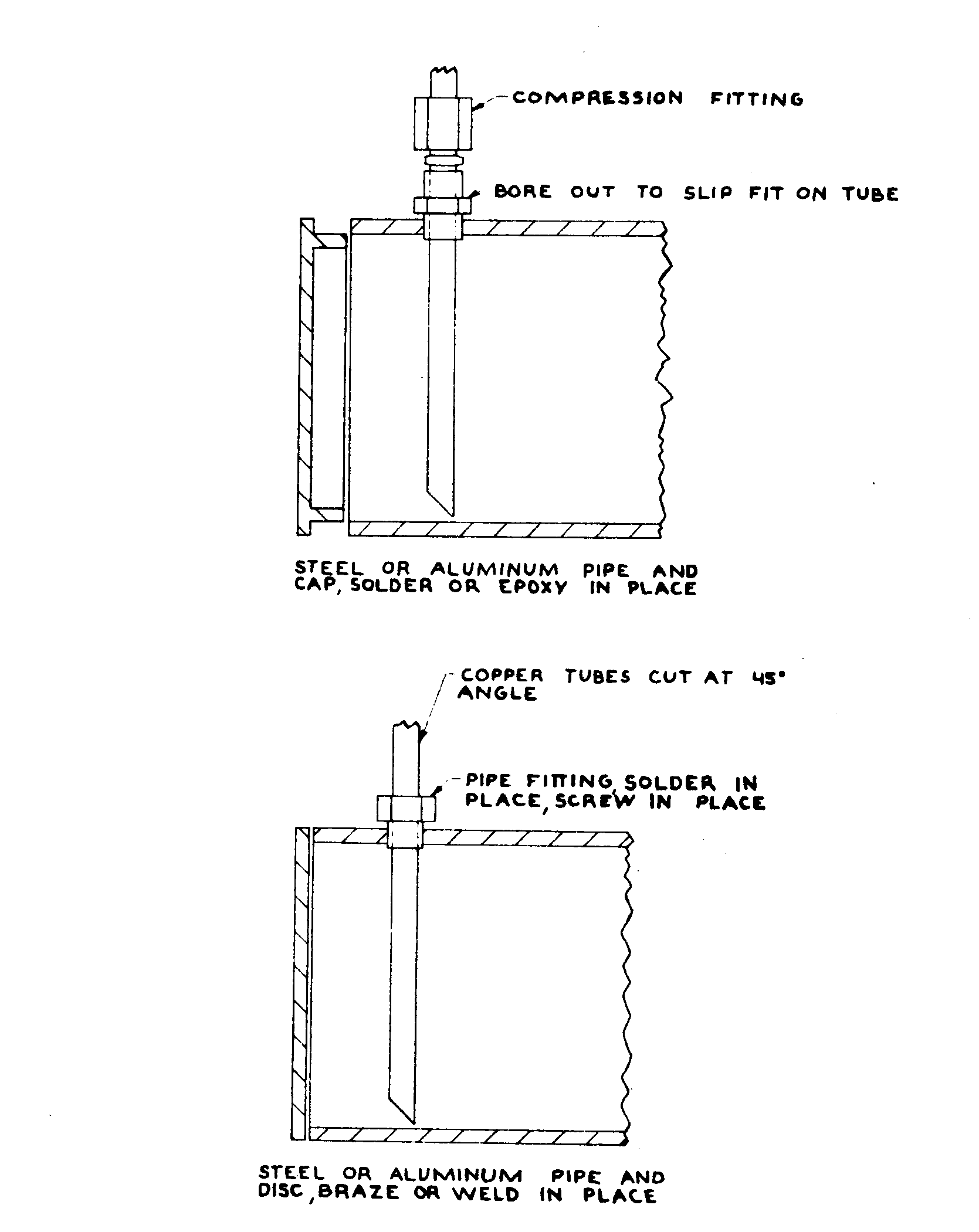
4. Of course, a good Heliac welder can do a quick and secure job of fastening on the end caps and stub tubes. If you and your friends were going to make a number of wheels, you might negotiate a reasonable mass-production price at a well-equipped welding shop.
5. If you are working with thin-walled tubing, the connecting tube may be brought through a thick end cap by threading in a street ell, or welding on an ell fitting. In that case, you may choose to use a fairly sturdy pipe as the crossover tube between tanks, which can also do double duty as a spoke of the wheel.
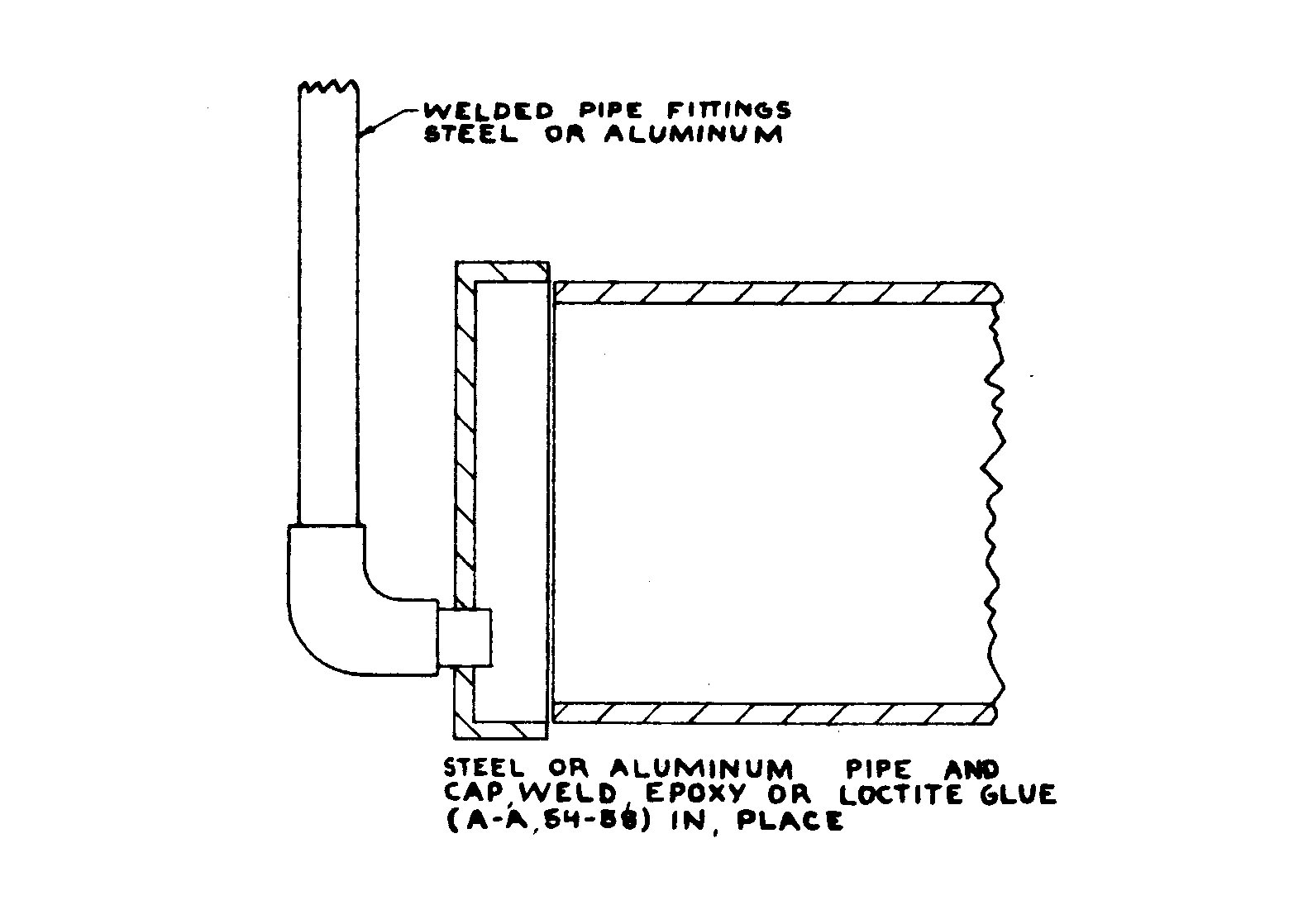
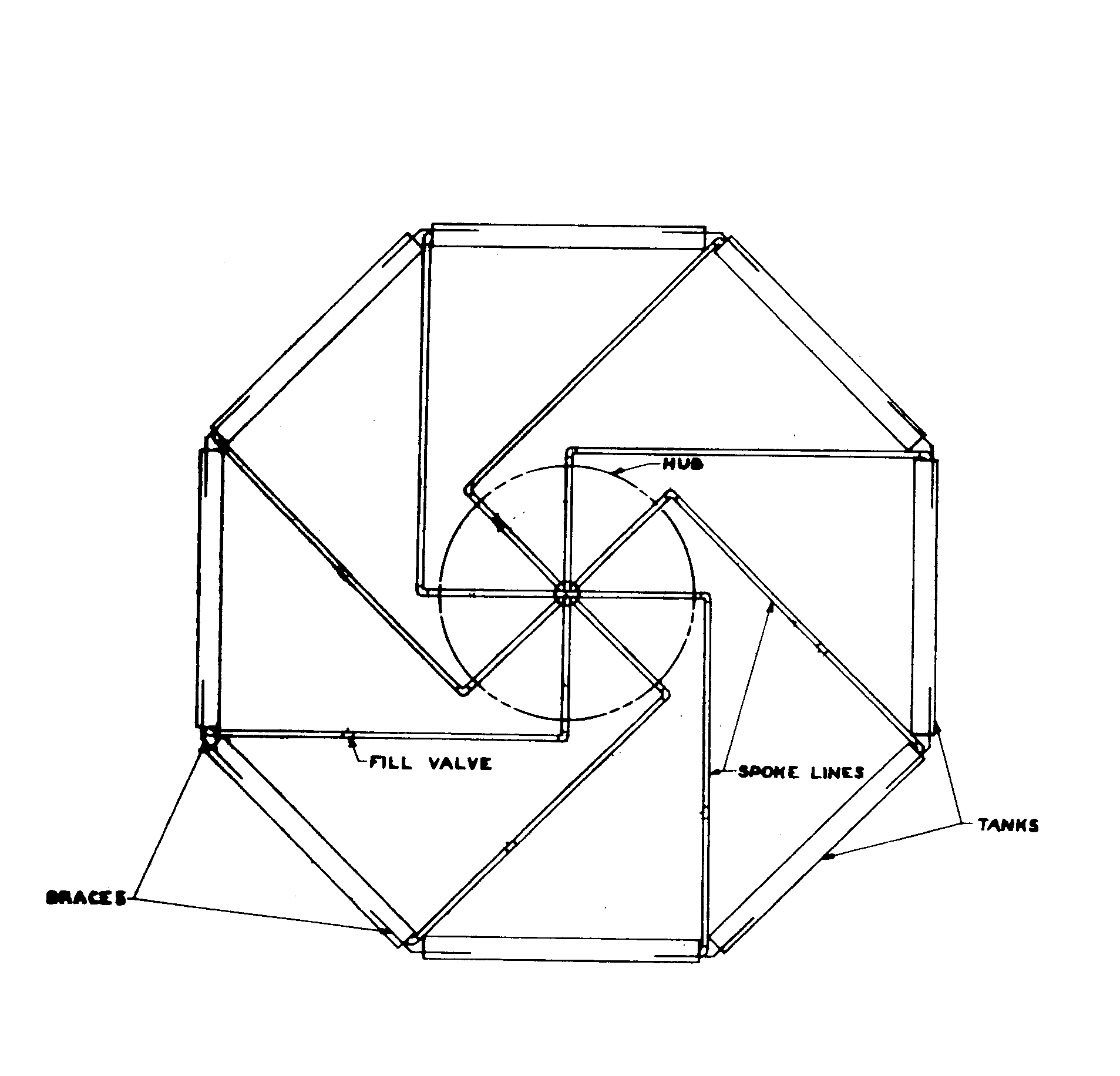
If you make the tanks from thin steel pipe (Schedule 20 or 10), their fabrication should be well within the capabilities of an ordinary electric welding machine or a flame brazing torch.It must be emphasized that all joints must be made with care to be permanently leakproof under pressure. If this is done, the Minto wheel can produce power for generations, since there is no way for its working fluid to escape.
Once your tanks have been fabricated and tested, you have finished the hardest part. The next most important component is the central support hub and axle.
We have shown how to construct the central support hub and axle on a bare-bones basis, using a short length of 3 inch pipe, some square steel plates and a home-made bearing. But here a little browsing at an auto junk yard can give inspiration to your ingenuity. A rear axle and differential housing provides an excellent bearing assembly, with the added advantage that the former drive shaft will run at higher RPM than the wheel mounted on the axle. Of course, you will have to stop the other axle from turning - or mount another Minto wheel on it to double the power output at the drive shaft. (Make sure you mount them so both turn the same way.) Also remember that the lubricating oil will run out of some differentials unless the drive shaft is horizontal.
A pair of old front wheel suspensions, complete with steel wheels, can also solve your bearing and hub assembly problems.
If none of these options is open to you, then make the bearing assembly as shown in the prints. The piece of 3 inch iron pipe should be polished with emery paper or any available abrasive.
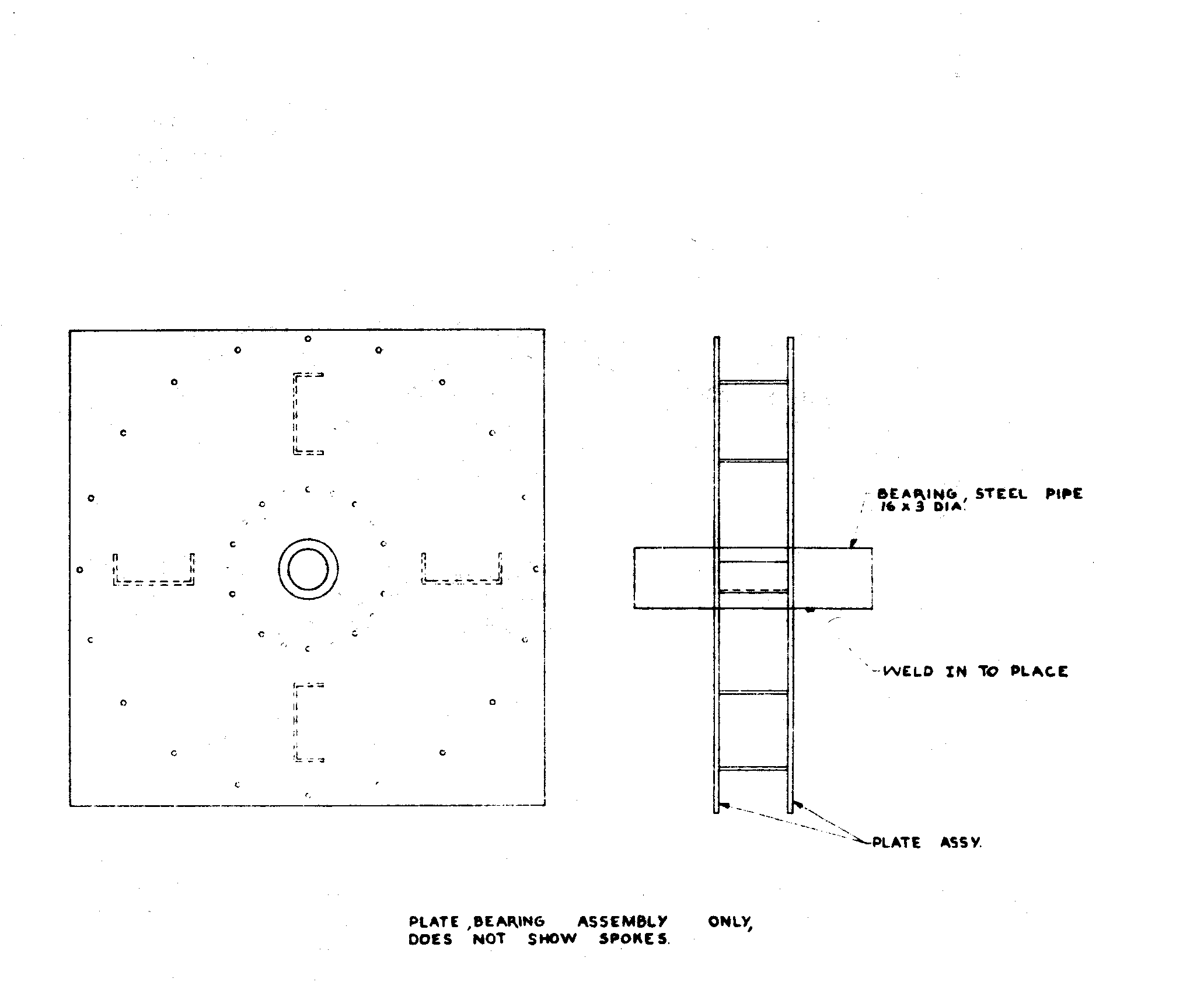
The pillow-blocks may be of wood, jigsawed, rasped or carved to a reasonable fit with the pipe axle. It is preferable, but not essential, to line the wood with a sheet of copper or lead. Or pour molten babbit, plumber's solder or similar soft metal in a wooden
form to a level half way up the diameter of the axle, to make a long-lasting bearing. After pouring, remove the axle from the solidified metal and scrape the alloy lightly to smooth it. Occasional greasing will let it run for decades, especially if you protect the axle from weather by tacking a piece of old tire or tube over the bearing-axle junctions.
We have shown the spokes made from aluminum angles, since these are light and durable. However, any other material or shape of adequate strength will do. Aluminum channel, pipe or tubing is fine, or even steel pipes will suffice at a cost of added maintenance to retard rusting. Heavy walled plastic water pipe will give excellent durability, but the number of spokes should be doubled to compensate for the lesser rigidity.
The blueprints show a minimum number of spokes to minimize labor. You may find it desirable to add cross bracing to these, particularly if you build a larger wheel or use heavier tanks.
A taut lacing of wire or light cable, in the manner of the spokes on a bicycle wheel, will also improve rigidity.
The Support Stand:
The support stand is shown as made from ordinary two by four lumber. This will last longer if pressure-treated lumber is used. But it is more durably fabricated from steel angles or galvanized pipe, bolted or welded together. Either one should be supported off the ground on masonry, rocks or cement blocks to prolong its life. There is lots of room for improvisation here. Just remember to build with triangles, not rectangles.
Triangular framing provides stiffness and rigidity with a minimum of materials used.
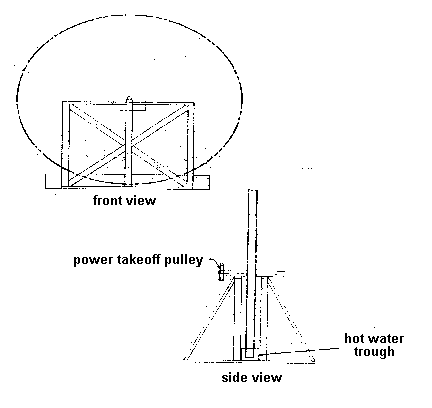
POWER TAKE OFF:
Since there are so many uses for power, we can only give some general guidelines and a few illustrations. These facts should be kept in mind: The Minto wheel likes to work; like its ancestor, the water wheel, it is a high-torque, low-speed mechanism. It operates most efficiently just below its maximum torque-capability. Of course, its output can be converted to higher RPM by gears, chains, and sprockets, cable or rope drives, belts and sheaves, etc. But, it is most effective at jobs which use high torque at low speed, such as irrigation or grinding grain.
1. Always remember that horsepower is Proportional to the product of torque times RPM. A given wheel, operating across a given temperature gradient, will provide a particular maximum horsepower when fully loaded. If loaded less than that maximum, it will provide the output needed to drive its given load. It is self-regulating up to its maximum or stall torque.
2. The power take-off drive train should be designed to match your power requirements at the RPM of the final driven device. If you are pumping water, a low speed piston or well pump is easily driven with a simple crank arm fixed to the axle of the wheel. Two or more pistons have a smoother demand for power, and a wheel will more efficiently drive them if they are phased oppositely.
The wheel can easily drive a drum which hoists an endless series of pails to lift water from a well. Similarly, you can drive an air-compressor, such as an old piston refrigeration compressor or an air-conditioning compressor from a junked automobile (Ford type is best). The compressed air can be stored in a tank to drive any air motor to do anything.
You can pump water uphill into a pond or other reservoir and use this stored power to drive a small Pelton wheel to produce power on demand.
3. If you require a higher RPM in a directly driven device, it should be realized that ordinary V-belts and sheaves can not transmit the high torque of a Minto wheel, at least in the primary stages of gearing up to higher RPM.
For the first and possibly second stage of speed multiplication, use sprockets and motorcycle chain, or cable or rope drives, or gearing.
Here, mounting the wheel on an old automotive differential is advantageous, since the output will be geared up at least 3 to 1, depending upon the assembly chosen. If the original differential drive shaft is coupled to an automotive transmission (manual type) a further step up in speed will be obtained, along with the versatility of a variable speed output. After going through these speed multiplication gear stages, ordinary V-belts and sheaves should handle the probable torque demands of later higher-speed power requirements.
On the other hand, if you choose the simple axle and sleave bearing mounting, you can easily convert an old steel auto-wheel to a drive sprocket. Just weld or bolt studs on the rim, carefully spaced to coincide with the holes in the sprocket chain to be used. You do not need a stud per hole: eight or ten around the rim is usually adequate. But they must be set on a circumference of the wheel that is an integral multiple of the distance between adjacent holes in the chain.
A convenient method is to use bicycle sprockets and chain, fastening the pedal sprocket to the wheel axle and the small sprocket to a pulley shaft. For higher torque, use two or three bicycle sprockets and chains working in parallel. Or use the stronger sprockets and chain from a motorcycle. Another alternative is to fasten the output end of an old car transmission (manual type) to the wheel axle.
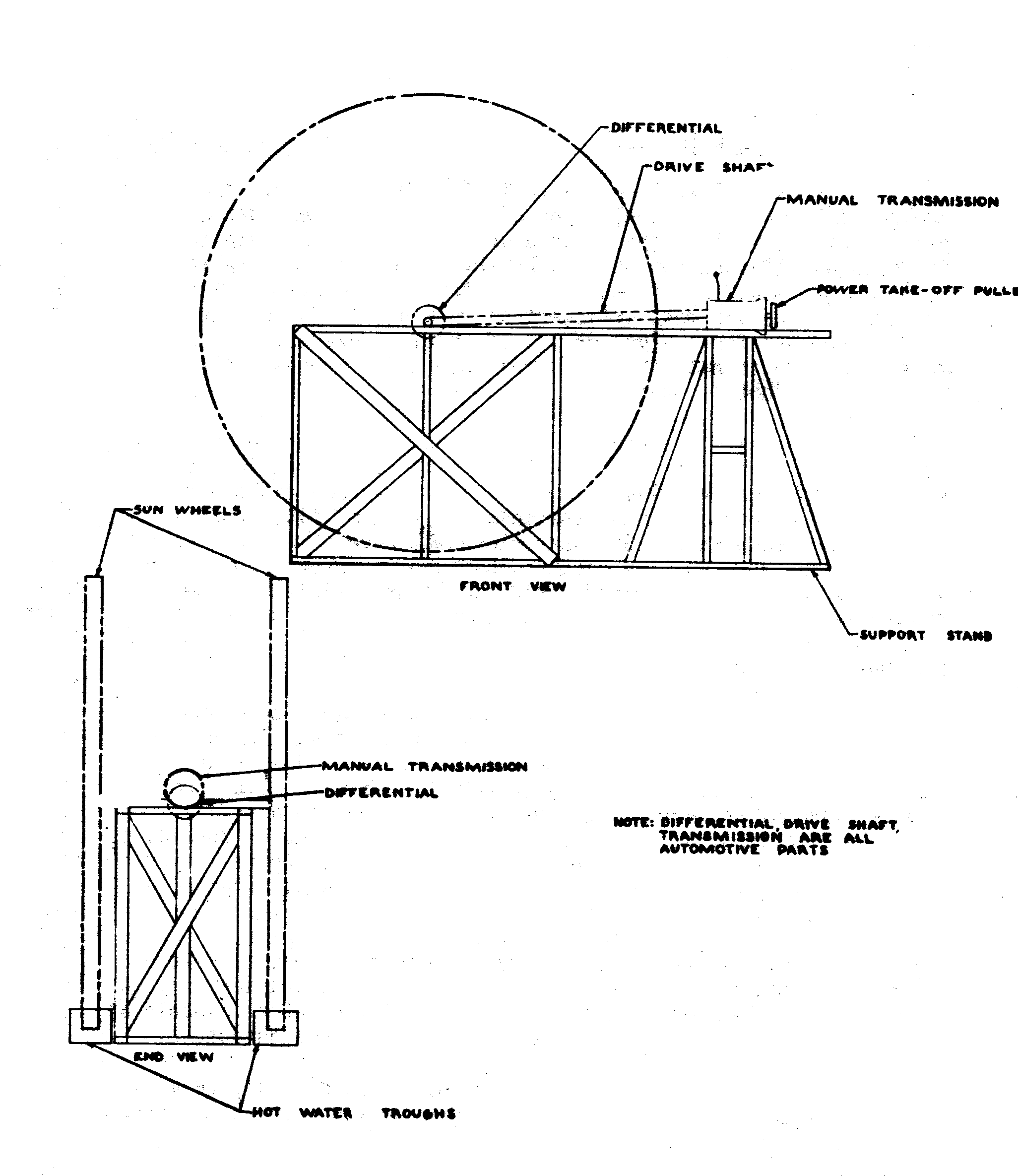
FILLING THE WHEEL WITH FLUID:
Many fluids are available for this purpose. Your choice will depend primarily upon a trade-off between cost and efficiency, as well as the temperature gradients available to you. The man-made fluids, represented by the freon family, have relatively high liquid densities and very low heats of vaporization. Therefore, they are most efficient as working fluids, producing the most horsepower for a given design of wheel. However, they are more expensive than the readily-available hydrocarbons, like butane, or liquified "bottled-gas".
A third class of fluids consists of solutions of one substance in another, such as carbon dioxide dissolved in washing soda solution (essentially "club soda"), or propane dissolved in kerosene. We recommend that the solution type of fluid be used only by more sophisticated constructors who have the expertise to deal with the more complex factors involved in desorption and re-sorption. However, these can yield excellent efficiencies because the heat of solution is lower than the heat of vaporization.
FILLING THE SYSTEM:
The fluid is put into each pair of tanks by means of a fill valve on each connecting tube. Of course, the fill valve can be on one tank of each pair. You can conveniently improvise a fill valve with the valve from a bicycle tube or a metal valve stem from an automotive inner tube. Other choices are to use fill valves available at an air-conditioning supply store, or the valves that come on freon tanks. The latter is a logical choice if you use the one-way freon tanks available from your local air conditioning shop.
In filling the tanks, it is very desirable to remove as much air as possible from each pair before filling and sealing.
The presence of air reduces the pressure differential attainable at a given temperature gradient, cutting down the power output.
There are a number of ways to remove most of the air, depending upon what equipment is available to you - or even without equipment.
Some Choices are:
1. Your refrigeration service man usually has an old compressor which will pull a decent vacuum through the fill valve.
2. An automotive air conditioning compressor from a junk yard can be directly-driven by an electric motor to evacuate the tanks.
3. You can obtain a "water aspirator" from a chemical supply house (or drug store) for several dollars which will pull a decent vacuum when hooked up to a garden hose, even at low domestic water pressure.
4. If you have no source of vacuum, merely admit some of the working fluid of your choice into the system through the fill valve, wait a few minutes for mixing, turning the wheel by hand, then vent the mixed gases. Three or four repetitions of this flushing will adequately remove air from the system. If you choose to fill the tanks with freon, we suggest you flush with "bottled gas", since that is cheaper and entirely compatible with the freon.
When most of the air is removed from the system, each pair of tanks is filled With enough working fluid to fill one tank with liquid and its opposite with vapor. Since the exact amounts are not critical, simple measurement of the tank dimensions will enable you to calculate the volumes of the tank. The tables in the appendix will allow you to estimate the weight of fluid to be put in the fill tube.
The most direct way to determine the weight of fluid placed in each pair of tanks is to weigh the supply tank. If the supply tank is connected to the fill valve with a flexible tube, you can continuously monitor its weight on a bathroom scale.
If that is not readily available, make a simple equal-arm balance from a length of lumber and hang the supply tank on one end and a bucket on the other. Fill the bucket with water until balance is achieved, then remove from the bucket a measured amount of water equal to the weight of fluid you wish to put in. A pint is a pound and a liter is a kilogram. The beam will balance again when the correct weight of working fluid has entered the system.
If you do not have a bucket big enough, hang the supply cylinder at some measured shorter distance from the pivot point and use the appropriate factor in determining the amount of water to be removed.
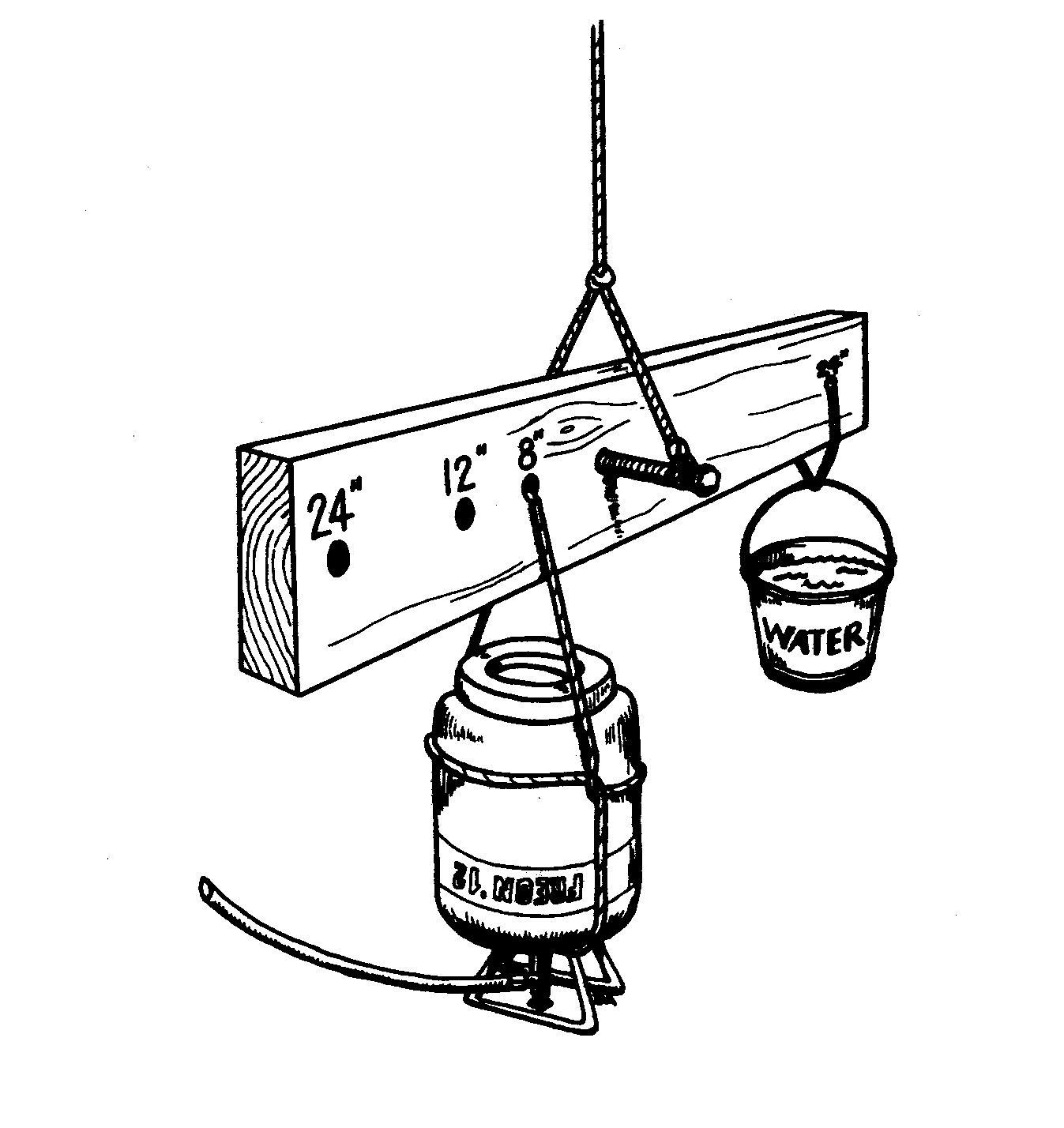
DESIGN CONSIDERATIONS:
The Minto Wheel is designed to utilize relatively small temperature gradients to produce useful mechanical energy. A hot spring or solar heated water will drive it nicely. Be very careful to chose a liquid which will not produce a pressure too high for your tank walls. Do not try for very high temperature differences unless you are familiar with analysis of mechanical strength of the tanks. We advise against using high-temperature heat sources (such as flames) to drive the system, unless you are qualified to make the required analyses of stresses.
TANK SIZE:
Do not be too ambitious in the size of tanks used. As the diameter of the tank is increased, its liquid capacity goes up as the square of the diameter, but the area available for heat transfer increases only linearly with the diameter. Heat transfer determines the op wer output. A wheel with small tanks will develop less torque, but will run faster. Remember that the power output is proportionate to torque times RPM.
Usually, tanks with diameters of from three to eight inches are most satisfactory. The length of the tank can be varied to suit the diameter of the wheel. Any variation in the length of the tank varies the volume and area in the same ratio. A long slim tank is better than a short fat one.
We recommend that at least eight tanks per wheel be used, but more than sixteen becomes somewhat complicated by the large number of crossover tubes threading through the hub area. Layout is simplified by using an even number of pairs, rather than an odd number of pairs. In other words, use eight, twelve or sixteen tanks (four, six or eight pairs) rather than ten or fourteen tanks (five or seven pairs).
CALCULATIONS:
To determine the weight of fluid needed to fill your chosen tanks: If they are cylinders, take the inside diameter of the tank and multiply it by itself, then multiply the product by 0.7854 to get the cross-sectional area. Multiply this number by the length of the tank to get its volume. Be sure that all measurements are made in the same units. If measured in inches, the result will be in cubic inches. If in centimeters, the result will be in cc. or ml. The tables in the appendix are given in English units of pounds per cubic foot, so your cubic inch result should be divided by 1728 to read out in cubic feet. Our metric friends only need to move the decimal point three places to the left to get liters, or six places to get cubic meters.
Remember that the total weight of fluid put into each pair of evacuated tanks should be equal to one tankful of liquid plus one tankful of vapor, at the probable operating temperature. The tables in the appendix will supply the necessary data to calculate the desired weiqht from the known volume of your tanks. This is not a critical matter but leads to maximum efficiency of operation. It is similarly desirable, but not essential, to have an equal weight of fluid in every pair of tanks on the wheel.
Operation of the wheel:
The power output of the wheel is proportionate to the rate at which heat is transferred into the liquid at the bottom and out of the vapor at the top,
For a given temperature difference, a hot water bath will transfer heat to the bottom tanks at a rate about forty times faster than hot air will.
So, we recommend that you use hot water to heat the bottom tanks, when feasible. The water may be heated by solar radiation, as with a solar collector below the bath level to heat it by convection. If you have a geothermal spring, your worries are over, and it need be only twenty degrees or so warmer than the air to give a reasonable power output.
Similarly, if you are using the wheel to pump water, arrange to have a few drops dripping on the top of the wheel to cool the upper tanks by evaporation. This increases the temperature difference across the wheel and increases power output. Even if you have no cool water, a bucket with a wick siphon dripping on the top of the wheel will help greatly, especially in hot, dry climates.
We have mentioned that the wheel likes to work and should be loaded to maximum torque for best efficiency. The optimum speed is easily determined for your particular wheel and heat source by putting into one of the crossover lines a small "bulls eye" type sight glass. These are available at your local air conditioning service man. Only one need be built into one cross-over line if all your tanks are similar.

The load should be adjusted so that liquid starts to spurt up the cross-over line when the bottom tank of that pair is horizontal. Bubbles of vapor should start to show in the sight glass as the tank trailing behind this one becomes horizontal. By adjusting the load on the power take off, and the depth of the water bath, this ideal may be approached.
Power output of the wheel:
Of course, you can just build a wheel and load it until it is working at maximum efficiency, then see whether it will do the job you hoped it would. But it is not difficult to calculate how much power it should turn out. The basic rules were worked out by Lazare Carnot (1753-1823) for water wheels, the major prime movers of his day, which were pure gravity engines. It is interesting that his son, Sadi Carnot, (1796-1832) is the author of the Carnot Theoreum of modern thermodynamics. Sadi took his father's formulae for power development by water wheels and converted it to the potential power output of heat engines. Sadi likened the "caloric fluid" to water, and the temperature through which it dropped to the height through which the water dropped. Today, we know that Lazare Carnot was correct, since the amount of water coming out the bottom of a waterwheel is the same as the amount of water going into the top. We also know that the amount of heat coming out of a heat engine is less than the amount of heat going into it. But in Sadi Carnot's day, the efficiency of steam engines was so low that he could not detect the difference between the "caloric fluid" going into the engine and the amount coming out. So he incorrectly applied his father's water wheel formulas to heat engines in 1824.
I do not wish to digress with this historical diversion, but it should be realized that this wheel is a synthesis of both the Carnots, father and son. It is a gravity engine operating on the principles of the water wheel, driven by a temperature gradient.
Back to our calculations:
If a weight of any substance falls through a vertical distance, its potential energy may be converted into kinetic energy. If one pound of weight falls one foot, it can develop one foot-pound of energy. Power is the rate of delivery of energy. It has been established that one horsepower is the equivalent of delivering 33,000 foot-pounds of energy per minute. Or 4500 kilogram-meters per minute.
To calculate the horsepower output of your wheel then, it is only necessary to know its diameter, and the weight of liquid transferred from bottom to the top tank each minute. The product of these two, divided by 33,000 will give you the horsepower. This is Lazare Carnot, upside down.
Well, its easy enough to measure the diameter of the wheel, but how much weight will transfer per minute? Here is where Sadi Carnot's theorem takes over. The greater the temperature difference, the higher the efficiency. Put Lazare and Sadi together and you get a "snowball effect".
Let's state it this way: The greater the temperature difference between the bottom and top of the wheel, the greater is the power output and efficiency of conversion of heat to power.
Let us get back to calculating how much weight will be transferred per minute.
To determine this, let us look at what happens. In the bottom tank, we must vaporize a quantity of liquid to fill that tank with vapor. The vapor displaces almost a tankful of liquid into the upper tank. You already know the volume of the tank, so you must calculate the weight of vapor it takes to fill it, at your probable operating temperature. This number you can get from the tables given herein. Then you read out, on the same line, the heat of vaporization per unit weight. This gives you the amount of heat you have to put into the bottom tank to empty it. {Pounds of vapor times heat of vaporization per pound.}
Now you know how much heat (measured in British Thermal Units, BTU's) you have to put into the tank to empty it and drive the liquid into the top tank.
But power depends upon the rate of heat flow. Knowing how many BTU's have to flow into the tank, you must next figure out the rate of heat flow. The heat flow rate depends upon the temperature difference between the water bath and the contents of the tank. For each degree Fahrenheit of temperature difference between the water bath and the working fluid in the tank, about 5 BTU's will flow per minute per square foot of tank wall area.
If you are not familiar with thermodynamic calculations, this may seem like a big chunk to swallow. But if we cut it up into little pieces, it is not hard to digest. And you would really like to make a reasonable prediction of what your wheel can turn out~ So let's take an example, step by step, to illustrate the principles:
Let us say that we make the tanks from three lengths of aluminum irrigation pipe of four inch diameter. If we cut each length into five foot sections, we will get about four tanks per piece of pipe, giving 12 tanks for our wheel. If the wheel is somewhat over 60 feet in circumference, it will be about 20 feet in diameter. Those are the basic facts. ~
We can calculate that each tank has a heat transfer area of 4 x 3 14 ( ) square inches per inch of length, multiplied by 60 inches of length gives about 754 square inches. Since there are 144 square inches in a square foot (God bless the metric system) the 754 square inches converts to 5.24 square feet per tank, We will ignore the area of the end caps as a little "fudge factor" in our favor,
Now we put in the 5 BTU~s per minute per square foot per degree Fahrenheit. So we know each tank can transfer 5 times 5.24 or about 26 BTU's per minute for each degree temperature difference between its contents and the water bath.
Next we will assume the ideal case, where we heat up and vaporize only the weight of fluid required to fill the tank volume.
We can calculate that the volume of one tank is:
4" x 4" x 0.7854 x 60" = 754 cubic inches
or 754/1728 = 0.436 cubic feet
If we are using freon - 12 as our working fluid, and pick a reasonable intermediate temperature of lOOF, reference to the tables in the appendix show that its vapor has a density of 3.135 lbs/cu. ft. at that temperature. Therefore the weight of F-12 that has to be vaporized to displace the liquid in the lower tank is:
0.436 x 3.135 lbs = 1.37 lbs.
From the same table on the same line, we see that it takes 57.46 BTU to vaporize one pound, so the amount of heat to be transferred into the tank is:
1.37 lbs x 57.46 BTU = 78.54 BTU
How much mass is transferred? Well, we started with a tankful of liquid. Our tables tell us that liquid F-12 at 100F weighs 80.11 lbs per cubic foot, and we know that a tank holds 0.436 cu ft.
80.11 x 0.436 34.93 lbs per tank
Of course, we are going to convert 1.37 lbs of the liquid into vapor, so the net transfer of liquid will be:
34.93 - 1.37 : 33.56 lbs
Since our wheel is about 20 feet in diameter, each tankful will provide nearly:
33.56 x 20' = 671 foot pounds of energy
In our example, twelve tanks will empty per revolution; we will get:
12 x 671 = 8050 ft lbs/revolution
If this work was used for hoisting water with an endless bucket chain, we can readily calculate that the 8000 ft. lbs of work per revolution is equal to that required to raise 95 gallons of water ten feet for each revolution of the wheel. In practice, somewhat less would be raised because of friction and other losses, but we are merely trying to approximate the magnitude of the useful work to be realized from the conditions of this example.
Let us continue by calculating how many revolutions per minute would be expected.
We said earlier that the rate of doing work is a function of the rate of heat flow. The rate of heat flow is governed by the area and the temperature difference. In our example, the tanks have an area of 5.24 square feet and a heat transfer coefficient of about 5 BTU per minute per square foot, so each tank will transfer 26 BTU per minute per degree Fahrenheit difference from the water bath. If the bath has water heated by solar panels, it might easily have an average temperature of 140F, or 40 more than the tank.
So, our heat flow rate would be:
40 x 26 BTU = 1040 BTU/min/tank
We have already calculated that, under ideal conditions, it takes 78.54 BTU to empty the tank. Therefore a tank ideally should empty in:
78.54/1040 = 0.0755 min or 4.5 seconds
Since there are twelve tanks on the wheel, it would ideally make about one revolution per minute and hoist 95 gallons of water per minute through ten feet.
Remember that this is a theoretical calculation and your wheel will produce work at a somewhat lesser rate than the theoretical. If your specific embodiment produces half the theoretical work output, it would be equivalent to hoisting a 50 gallon drum of water up ten feet every minute. This is considerably more work than a man can perform on a sustained basis.
The wheel does not produce a high RPM, high power intensity output. If you have need for high intensity output, such as driving an electrical generator, then consider another innovative approach. Like the Minto wheel, this is also a gravity engine driven by a thermal gradient. But a different sequence of actions occur.
THE ARTIFICIAL HYDROLOGIC CYCLE
This prime mover is useful in more special circumstances. It uses a moderately-high temperature gradient (achieving greater Carnot efficiency) and a substantial difference of elevation, such as a mountain or high building. The basic principle involves the vaporization of a low-boiling liquid at modest pressure, such as a hot spring can produce. The vapor flows upward through a well-insulated pipe to some higher elevation, doing work against gravity. At the highest point it flows into an air-cooled condenser, wherein it gives up its heat and reverts to liquid form. The liquid flows back downhill through a pipe to produce a substantial hydrostatic head. The high pressure liquid drives an hydraulic motor. The exhaust of the motor flows into the vaporizer to close the cycle. The example gives details for one set of circumstances.
This form of prime-mover requires some precision-built machinery in the hydraulic motor. But it has a greater intensity of power output. (High torque at high RPM) Nonetheless, the components are durable and not expensive. If the necessary sources of altitude and heat are available, it has a very high cost effectiveness and excellent durability. Like the wheel, once built, it can turn out power for generations to come without consuming irreplaceable fuels.


The following email was received with regard to the wheel and the best refrigerant to use; On Monday 09/10/01, from Dr. William H. Rhodes, discoverer of Hydroxy gas (ripped off as Browns gas), comes the recommendation to use the following for the heat transfer fluid; METHYLENE CHLORIDE AS A HEAT TRANSFER MEDIUM FOR THE MINTO WHEEL Here's a workup on Methylene Chloride for driving the MINTO Wheel. CH2CL2 molecular wt 84.94. Vapor is not flammable and when mixed with air not explosive. Boiling point at sea level is 39.75 C. (103.55 F.), condenses 5 degrees F below boiling point. Soluble in about 50 parts water. Listed as an anesthetic via inhalation. Sweet odor. Compare with Freon 12 (dichlorodifluromethane) Molecular Wt 120. Boiling point -29.8 C (-21.64 F.). Critical temperature 115.5 C (239.9 F.). Compare both with Water. H20 molecular wt 18.016. Compared with water, Methylene Chloride (MCL) is twice as heavy. Freon 12 is heavier still, but presents the problem of soaring pressure with mild temperature increases. A container sitting in the sun can easily attain 200 - 300 psi. Methylene Chloride's temperature/pressure relationship is mild by comparison. The main reason for choosing MCL is its narrow liquid/boiling differential. The down side, any moisture or humidity left inside tanks and tubing will oxidize them from chlorine liberated because of the hydrochloric acid produced from the moisture reacting with MCL. Stainless steel offers no protection. Fortunately, several options exist to avoid this. Regardless of the fluid chosen, tanks and tubing must be strong enough to avoid collapsing under 15 psi (Atmospheric pressure.). All refrigerants, of which MCL is one, condense to liquid, leaving nothing but a vacuum behind. The best way to rid the interior of all moisture is by loading each MINTO segment with acetone about half the volume of the segment. It is then closed off and sloshed around to make certain all surfaces have been wet. It can then be drained into a jug and used for the next segment since the few drops of moisture picked up will not saturate the acetone. Acetone will absorb all the moisture, and leaving a film of it behind doesn't interfere with function. Furthermore, any moisture trapped in acetone cannot react with MCL to rust the interior. LOADING THE SYSTEM WITH METHYLENE CHLORIDE. It should have been stated above that sealing off MCL requires special attention -- more-so than Freon. The best gaskets are polyethylene, and gasket seats must be clean and free from foreign matter. Such gaskets can be made from discarded bottles, if one has the tools. Prefigure the correct amount of fluid required for each MINTO segment. Use a polyethylene or aluminum funnel and empty the contents into it. This should be done outside in open air. Stand sideways to any breeze to avoid creating the vapor. Don't make the error of standing with your back to the wind, vapor will be sucked back into you face. It's not toxic in small amounts. Once a segment has been charged, screw the plug or close the valve and allow it to sit for a few minutes. You must now remove the air which will contain a mixture of MCL and acetone plus absorbed moisture. A moderate source of hot air should be available for this. Do no use a torch. Overheating MCL can decompose it. Assume the MINTO segment with the fluid is on the bottom, and its other segment is on top and contains the plug or valve. Locate the plug area where you can see over the top and past it. Slowly heat the bottom segment until you see vapor coming from the top. Allow it to continue until by cupping your and wafting the vapor toward you it will smell sweet. Close the valve tightly and soon a high vacuum will form inside, and you are finished with that segment. Just like in refrigeration equipment, the wheel segments cannot function with air contamination present. An impressive experiment can be run to show the crushing power of atmospheric pressure. A clean 5 gallon can with a tight cap is loaded with a half cup of methylene chloride. Warm it a bit to void the air and close the cap down tight. If it's summertime, not much will happen, but from about 80 degrees down, it will soon start crunching inward from all sides. If it's cool enough, by morning it will look like a big wad of aluminum foil. I should add, it's noisy.
About using Iso-Pentane vs the availability of methylene chloride from Tue 09/11/01, also from Dr. Rhodes; ...About iso-pentane...it is flammable and carries the same pressure hazard as the freons. It's go for posting the Methylene Chloride item. You are free to list my name, but withold the email address. MCL is used as a paint and varnish remover. It should be available from Home Depot, or a chemical supply company. It's not cheap, but well within the means of average dude. It must be tightly sealed to prevent evaporation. Mine is contained in a 9 gallon stainess steel container, a military item used for oxygen, with a refrigeration valve. However, it may be stored in the container purchased. It should be stored in an area with ambient heat at 80 F.